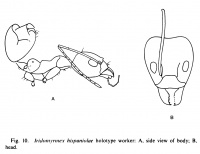Technomyrmex hispaniolae
| †Technomyrmex hispaniolae Temporal range: Burdigalian, Early Miocene Dominican amber, Dominican Republic | |
|---|---|

| |
| Scientific classification | |
| Kingdom: | Animalia |
| Phylum: | Arthropoda |
| Class: | Insecta |
| Order: | Hymenoptera |
| Family: | Formicidae |
| Subfamily: | Dolichoderinae |
| Genus: | Technomyrmex |
| Species: | †T. hispaniolae |
| Binomial name | |
| †Technomyrmex hispaniolae (Wilson, 1985) | |
Described from Dominican amber fragments. This ant possibly belongs to a different genus. See comments under Technomyrmex caritatis. (Bolton 2007)
Identification
Fernández and Guerrero (2008) - This extinct species is characterized by long scape, metanotum longitudinally striate, petiole very long and slender and the presence of one pair of long setae on vertex.
Distribution
This taxon was described from Dominican amber, Dominican Republic (Burdigalian, Early Miocene).
Castes
Nomenclature
The following information is derived from Barry Bolton's Online Catalogue of the Ants of the World.
- †hispaniolae. †Iridomyrmex hispaniolae Wilson, 1985c: 32, fig. 10 (w.) DOMINICAN AMBER (Miocene). Combination in Linepithema: Shattuck, 1992a: 16; in Techomyrmex: Brandão, Baroni Urbani, Wagensberg & Yamamoto, 1999: 414. Incertae sedis in Technomyrmex: Bolton, 2007a: 123.
Type Material
- Holotype, worker, Las Bocas del Licey, in amber, Dominican Amber (Miocene), Museum of Comparative Zoology; see Bolton (2007).
- Paratype workers. (32 amber pieces) Dominican Republic: Carlos Diaz, El Valle, La Toca, Llaroa, Los Cacaos, Palo Quemado and Bayaguana (Museum of Comparative Zoology).
Fernández and Guerrero (2008) - There are two dolichoderine species described from Dominican amber that are ascribed to Technomyrmex (Brandão et al. 1999). However, Bolton (2007:122) points out that both species “lack some critical diagnostic characters of the genus, the absence of which would argue for their exclusion”. Bolton also questioned the classification of Technomyrmex hispaniolae in Iridomyrmex or Linepithema, leaving both taxa as incertae sedis in Technomyrmex.
References
- Bolton, B. 2007. Taxonomy of the dolichoderine ant genus Technomyrmex Mayr (Hymenoptera: Formicidae) based on the worker caste. Contributions of the American Entomological Institute. 35(1):1-149.
- Brandão, C. R. F.; Baroni Urbani, C. 1999 [1998]. Technomyrmex caritatis Brandão & Baroni Urbani, sp. n. Pp. 416-418 in: Brandão, C. R. F.; Baroni Urbani, C.; Wagensberg, J.; Yamamoto, C. I. New Technomyrmex in Dominican amber (Hymenoptera: Formicidae), (page 414, Combination in Technomyrmex)
- Fernández, F. and R. J. Guerrero. 2008. Technomyrmex (Formicidae: Dolichoderinae) in the New World: synopsis and description of a new species. Revista Colombiana de Entomología. 34:110-115.
- Perfilieva, K.S. 2022. Ants (Hymenoptera: Formicidae) from localities of the Russian Far East (Amgu, Velikaya Kema). Paleontological Journal, 56(4), 412–425 (doi:10.1134/s0031030122040086).
- Perrichot, V., Boudinot, B.E., Engel, M.S., Xu, C., Bojarski, B., Szwedo, J. 2022. Ants (Hymenoptera: Formicidae) from Miocene Ethiopian amber: filling gaps in the geological record of African terrestrial biota, Zoological Journal of the Linnean Society, 2022, zlac053 (doi:10.1093/zoolinnean/zlac053).
- Shattuck, S. O. 1992a. Review of the dolichoderine ant genus Iridomyrmex Mayr with descriptions of three new genera (Hymenoptera: Formicidae). J. Aust. Entomol. Soc. 31: 13-18 (page 16, Combination in Linepithema)
- Varela-Hernández, F., Riquelme, F., Guerrero, R.J., Vázquez-Franco, C.M. 2022. New ant species Schismiscapus exstinctum gen. et sp. nov. (Formicidae: Dolichoderinae) from Miocene Mexican amber. Historical Biology 34:1-7 (doi:10.1080/08912963.2022.2085568).
- Wilson, E. O. 1985c. Ants of the Dominican amber (Hymenoptera: Formicidae). 3. The subfamily Dolichoderinae. Psyche (Camb.) 92: 17-37 (page 32, fig. 10 worker described)